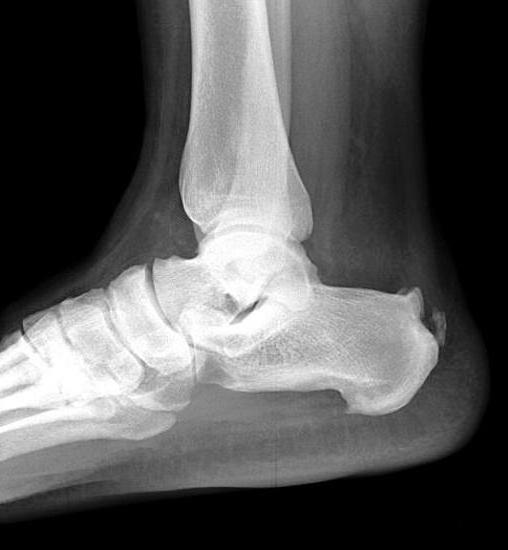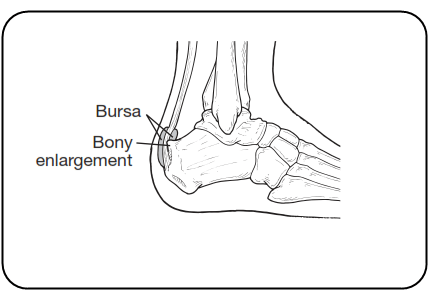Last Updated on November 12, 2019
Bony enlargement on the back of calcaneum [heel] is called Haglund deformity. It is also known as a pump bump or Bauer bump or Mulhulland deformity. It often causes retrocalcaneal bursitis due to the involvement of bursa that lies in vicinity. It is also called the pump bump because of its association with high heel shoes or pumps. In Haglund deformity, the soft tissue near the Achilles tendon becomes irritated when the bony enlargement rubs against shoes.
Haglund deformity is most common in young women who wear high heeled shoes or pumps. For that reason, it is also called ‘pump bump’.
It can occur in one or both the feet.

Causes of Haglund Deformity
High Foot Arches
High foot arches are associated with this deformity.
We know from the anatomy of Achilles tendon that Achilles tendon is inserted on the posterior aspect of the calcaneum. With high arches, calcaneum is tilted backward causing rubbing of calcaneum with the tendon. Persistent irritation leads to the development of bony protrusion and eventually retrocalcaneal bursitis. Redness and swelling associated with Haglund deformity are caused by inflammation of the bursa.
Tight Achilles Tendon
A tight Achilles tendon can compress bursa and increases the symptoms and swelling associated with it. In contrast, a tendon that is more flexible results in less pressure against the bursa.
Walk-in Supination
Walking in supination or on the outer aspect of heel and foot leads to inward heel rotation which causes rubbing of the tendon with bone.
Genetics is also supposed to play a role. The type of foot structure you inherit can make you vulnerable to get Haglund deformity.
Symptoms of Haglund Deformity
There is a noticeable swelling on the back of heel [also called bump]. There is a history of pain at the insertion of Achilles tendon on the calcaneum. The examination of the back of the heel might be warm, tender and reveal redness.
Lab Studies
Lab studies are not required for the diagnosis of Haglund Deformity but may be done to rule out other possible causes of retrocalcaneal bursitis.
Imaging
Xrays may show an increased prominence of the posterosuperior aspect of the calcaneus. Xrays of feet are also done to see the structure of the foot.
MRI is helpful in detecting the degenerative changes that occur within the Achilles tendon. Also useful to the surgeon to know the extent of the degenerative changes.
Treatment of Haglund Deformity
The treatment of Haglund deformity aims at the reduction of inflammation of a bursa and thus symptoms but does not reduce the bony protrusion.
The treatment includes the following.
Drugs
NSAIDs like diclofenac or ibuprofen are used to reduce inflammation and pain. Topical analgesics directly applied to the region also causes a reduction of symptoms
Ice Application
Ice packs or bag of ice is applied to the area for about 20 minutes. Avoid direct application of ice on the skin.
Heel Pads/ Shoe Modification/ Heel Lifts/Orthotics
Heel pads are pads placed in back o the shoes and relieve some of the pressure of the shoes.
Change of the shoe can be considered. Walking barefoot to relieve the pressure may help some patients.
Patients with high arches may be helped by heel lifts placed inside the shoe.
Orthotics such as custom arch support control the motion that can aggravate symptoms.
Surgical Treatment
Surgery is required when symptoms persist in spite of conservative treatment.
The surgical options include resection of a Haglund deformity, removal of painful bursa and debridement of the Achilles tendon insertion
Prevention of Haglund Deformity
This requires multiple approaches such as
- Wear proper shoes, avoid high heeled shoes
- Use arch supports or orthotic devices
- Proper stretch and warm-up exercises before the physical activity like running
- Avoid uphill running and running on hard surfaces.
